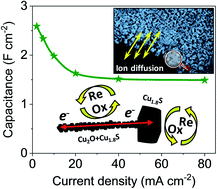当前位置:
X-MOL 学术
›
J. Mater. Chem. A
›
论文详情
Our official English website, www.x-mol.net, welcomes your
feedback! (Note: you will need to create a separate account there.)
A stable and high-energy hybrid supercapacitor using porous Cu2O–Cu1.8S nanowire arrays†
Journal of Materials Chemistry A ( IF 10.7 ) Pub Date : 2019-12-23 , DOI: 10.1039/c9ta12675a Ali Esfandiar 1, 2, 3, 4 , Mohammad Qorbani 1, 2, 3, 4, 5 , Indrajit Shown 6, 7, 8 , Badrosadat Ojaghi Dogahe 1, 2, 3, 4
Journal of Materials Chemistry A ( IF 10.7 ) Pub Date : 2019-12-23 , DOI: 10.1039/c9ta12675a Ali Esfandiar 1, 2, 3, 4 , Mohammad Qorbani 1, 2, 3, 4, 5 , Indrajit Shown 6, 7, 8 , Badrosadat Ojaghi Dogahe 1, 2, 3, 4
Affiliation

|
A three-dimensional electrode based on porous Cu2O–Cu1.8S nanowires is prepared by means of a facile fabrication process. In this electrode, nanowires are decorated with Cu1.8S polyhedral nanostructures on the top, which are directly grown on a copper foam, thereby eliminating the need for a polymer binder. As an electrochemical electrode, it exhibits an extrinsic pseudocapacitive charge storage mechanism, which is different from that of battery-like Cu2O–CuO and Cu(OH)2 electrodes. The areal and volumetric capacitances of the Cu2O–Cu1.8S electrode can reach 2.6 F cm−2 and ∼200 F cm−3, respectively, at 2 mA cm−2, which are much higher than those obtained using copper(I, II) oxide and hydroxide phases. An asymmetric hybrid supercapacitor device shows areal and volumetric energy densities of 204.8 μW h cm−2 and ∼2.1 mW h cm−3, respectively, at a power density of 3.1 mW cm−2 with a retention ratio of 55% at 15.5 mW cm−2. Besides, both the Cu2O–Cu1.8S electrode and the asymmetric hybrid supercapacitor device exhibit remarkable long-term cycling stabilities, with the capacitance retention of 91% and 94% after 15 000 cycles at the current densities of 40 and 20 mA cm−2, respectively. The porous copper sulfide phase in the fabricated electrode provides a reservoir of ions close to the surface, reducing the diffusion path lengths of ions into the electroactive solid network; this induces an improved electrochemical pseudocapacitive behavior. Our findings shed light on the role of surface modification for creating stable energy storage devices and present a simple way using cost-effective materials to generate more accessible active sites for charge storage on nanostructured electrodes.
中文翻译:

使用多孔Cu 2 O–Cu 1.8 S纳米线阵列的稳定且高能的混合超级电容器†
基于多孔Cu 2 O–Cu 1.8 S纳米线的三维电极是通过便捷的制造工艺制备的。在该电极中,纳米线的顶部装饰有Cu 1.8 S多面体纳米结构,该结构直接在泡沫铜上生长,从而消除了对聚合物粘合剂的需求。作为电化学电极,它表现出一种非本征的伪电容电荷存储机制,该机制不同于电池状Cu 2 O-CuO和Cu(OH)2电极。Cu 2 O–Cu 1.8 S电极的面积和体积电容可以达到2.6 F cm -2和〜200 F cm -3分别以2mA厘米-2,这比使用铜(获得的那些高得多的我,II)氧化物和氢氧化物相。非对称混合超级电容器器件在3.1 mW cm -2的功率密度下的面积和体积能量密度分别为204.8μWh cm -2和〜2.1 mW h cm -3,在15.5 mW cm处的保留率为55%。−2。此外,Cu 2 O–Cu 1.8 S电极和非对称混合超级电容器装置均表现出卓越的长期循环稳定性,在电流密度为40和20 mA cm的情况下,经过15 000次循环后,电容保持率分别为91%和94%−2, 分别。制成的电极中的多孔硫化铜相在表面附近提供了一个离子库,从而减少了离子向电活性固体网络中扩散的路径长度。这引起了改进的电化学伪电容行为。我们的发现揭示了表面修饰在创建稳定的能量存储设备中的作用,并提出了一种使用具有成本效益的材料来生成更多可访问的活性位点以将电荷存储在纳米结构电极上的简单方法。
更新日期:2020-01-06
中文翻译:

使用多孔Cu 2 O–Cu 1.8 S纳米线阵列的稳定且高能的混合超级电容器†
基于多孔Cu 2 O–Cu 1.8 S纳米线的三维电极是通过便捷的制造工艺制备的。在该电极中,纳米线的顶部装饰有Cu 1.8 S多面体纳米结构,该结构直接在泡沫铜上生长,从而消除了对聚合物粘合剂的需求。作为电化学电极,它表现出一种非本征的伪电容电荷存储机制,该机制不同于电池状Cu 2 O-CuO和Cu(OH)2电极。Cu 2 O–Cu 1.8 S电极的面积和体积电容可以达到2.6 F cm -2和〜200 F cm -3分别以2mA厘米-2,这比使用铜(获得的那些高得多的我,II)氧化物和氢氧化物相。非对称混合超级电容器器件在3.1 mW cm -2的功率密度下的面积和体积能量密度分别为204.8μWh cm -2和〜2.1 mW h cm -3,在15.5 mW cm处的保留率为55%。−2。此外,Cu 2 O–Cu 1.8 S电极和非对称混合超级电容器装置均表现出卓越的长期循环稳定性,在电流密度为40和20 mA cm的情况下,经过15 000次循环后,电容保持率分别为91%和94%−2, 分别。制成的电极中的多孔硫化铜相在表面附近提供了一个离子库,从而减少了离子向电活性固体网络中扩散的路径长度。这引起了改进的电化学伪电容行为。我们的发现揭示了表面修饰在创建稳定的能量存储设备中的作用,并提出了一种使用具有成本效益的材料来生成更多可访问的活性位点以将电荷存储在纳米结构电极上的简单方法。











































 京公网安备 11010802027423号
京公网安备 11010802027423号